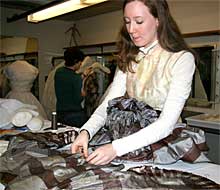New
Life for Old Clothes
|

Abbie Chase ’10 pins a bodice in the Historic Clothing
Workshop (photos by Roberge).
|
After about 150 years, a dress
that has been handed down through generations, worn on countless
occasions and eventually donated to a theater costume collection
might be considered to have exhausted its usefulness. Time
to retire the well-worn garment, many would say.
Not so, according to a dozen Smith students and a couple
of alumnae who spent laborious hours during a one-week workshop
this month inspecting, restoring, reconstructing and revitalizing
nine formal gowns dating from the 1850s to early 1900s.
The workshop, Historic
Clothing Conservation and Display Techniques, was led by
Colleen Callahan ’69, a costume
and textile historian and costumer from Richmond, Virginia.
Callahan led a similar workshop two years ago at Mount Holyoke
College and was invited back to her alma mater this year
to instruct students using the theater department’s
Historic Clothing Collection, said Kiki Smith, professor
of theatre, who oversees the costume collections.
In their restored state,
the dresses will live on as historic artifacts and reference
sources. Professor Smith will use the gowns in her theater
costume courses, she said, to demonstrate techniques for
making such garments, and to lend an authentic perspective
to period theater productions. Also, the workshop restorations
will be included in a large, ongoing project next week
that is compiling digital photographs of historic clothing
for the art department’s Insight image data
bank, used by several college departments. The restored dresses
will never be worn again.
Notable in the theater
department’s collection—though
not part of the restoration workshop—are two garments
worn by Sylvia Plath ’55: her high school prom gown
and her Girl Scout uniform, both circa 1940s—early
1950s.
The gowns in the restoration workshop were likely tailor-made
for their original owners, said Callahan, and would have
been considered very elite in their Victorian day, probably
costing more than $500, a small fortune at the time. After
years of make-shift alteration and handling during theater
productions, these historic dresses were a long way from
their original condition.
“Each one of these projects had different problems,” said
Callahan. “Some of them needed complete restoration,
some others needed stabilization.”
The gowns were all originally hand-sewn, in intricate patterns
featuring long, flowing bodices, pleated waistbands and laced
collars. To restore such detail, the students became necessarily
close to the pieces, tightly hand-sewing extensive seams,
recreating multi-pleated waists, and replacing worn material.
“When this workshop began, none of these could be
used as resources or reference pieces,” said Callahan. “Now
you can learn how they were put together, how a bustle-skirt
worked, for example.”
What Callahan hopes the students learned in the workshop
was an appreciation for the past and the clothes worn in
a bygone era, advanced sewing and restoration skills and,
not least, a sense of the social history that inspired such
clothing.
“For one thing, we learned about the subjugation of
women through corsets,” said Diana Chung, Mount Holyoke ’09,
adding as she focused on a long row of stitches, “and
I think we learned patience out of this.”
Emma Forrest ’11, who has participated in Civil War
re-enactments and some theater costuming, plans to use what
she has learned in the future. “I would like to consider
professional costuming either in theater or re-enactments,” she
said. “This has been a great experience to work on
these dresses.”
Compared to other types
of restoration, working with dresses and fragile fabrics
is a precarious skill, noted workshop participant Nora
Frankel ’08, who also restores wood
frames in the Museum of Art’s conservation lab. “If
you breathe on these materials they fall apart,” she
said. “Wood is a lot more forgiving.”
The nine workshop restoration
projects will become part of the college’s Historic Clothing Collection, an archive
of more than one thousand garments and accessories—mostly
donated by Smith alumnae—from a range of social classes
and in many styles.
|























